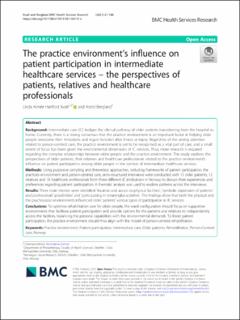| dc.contributor.author | Kvæl, Linda Aimee Hartford | |
| dc.contributor.author | Bergland, Astrid | |
| dc.coverage.spatial | Norway | en_US |
| dc.date.accessioned | 2021-06-17T13:50:26Z | |
| dc.date.available | 2021-06-17T13:50:26Z | |
| dc.date.created | 2021-02-26T09:20:58Z | |
| dc.date.issued | 2021-02-25 | |
| dc.identifier.citation | BMC Health Services Research. 2021, 21, (180). | en_US |
| dc.identifier.issn | 1472-6963 | |
| dc.identifier.uri | https://hdl.handle.net/11250/2760009 | |
| dc.description.abstract | Background: Intermediate care (IC) bridges the clinical pathway of older patients transitioning from the hospital to home. Currently, there is a strong consensus that the practice environment is an important factor in helping older people overcome their limitations and regain function after illness or injury. Regardless of the arising attention related to person-centred care, the practice environment is yet to be recognised as a vital part of care, and a small extent of focus has been given the environmental dimensions of IC services. Thus, more research is required regarding the complex relationships between older people and the practice environment. This study explores the perspectives of older patients, their relatives and healthcare professionals related to the practice environment’s influence on patient participation among older people in the context of intermediate healthcare services. Methods: Using purposive sampling and theoretical approaches, including frameworks of patient participation, the practices environment and person-centred care, semi-structured interviews were conducted with 15 older patients, 12 relatives and 18 healthcare professionals from three different IC institutions in Norway to discuss their experiences and preferences regarding patient participation. A thematic analysis was used to explore patterns across the interviews. Results: Three main themes were identified: ‘location and access to physical facilities’, ‘symbolic expression of patients’ and professionals’ possibilities’ and ‘participating in meaningful activities’. The findings show that both the physical and the psychosocial environments influenced older patients’ various types of participation in IC services. Conclusions: To optimise rehabilitation care for older people, the ward configuration should focus on supportive environments that facilitate patient participation and provide options for the patients and relatives to independently access the facilities, balancing the personal capabilities with the environmental demands. To foster patient participation, the practice environment should thus align with the model of person-centred rehabilitation. | en_US |
| dc.description.sponsorship | This work was supported by Dam Foundation. | en_US |
| dc.language.iso | eng | en_US |
| dc.publisher | BMC | en_US |
| dc.relation.ispartofseries | BMC Health Services Research;21:180 | |
| dc.rights | Navngivelse 4.0 Internasjonal | * |
| dc.rights.uri | http://creativecommons.org/licenses/by/4.0/deed.no | * |
| dc.subject | Practice environments | en_US |
| dc.subject | Patient participation | en_US |
| dc.subject | Intermediate care | en_US |
| dc.subject | Older patients | en_US |
| dc.subject | Rehabilitations | en_US |
| dc.subject | Person-Centred care | en_US |
| dc.subject | Norway | en_US |
| dc.title | The practice environment’s influence on patient participation in intermediate healthcare services – the perspectives of patients, relatives and healthcare professionals | en_US |
| dc.type | Peer reviewed | en_US |
| dc.type | Journal article | en_US |
| dc.description.version | publishedVersion | en_US |
| dc.rights.holder | © The Author(s). 2021 | en_US |
| dc.source.articlenumber | 180 | en_US |
| cristin.ispublished | true | |
| cristin.fulltext | original | |
| cristin.qualitycode | 2 | |
| dc.identifier.doi | https://doi.org/10.1186/s12913-021-06175-z | |
| dc.identifier.cristin | 1893910 | |
| dc.source.journal | BMC Health Services Research | en_US |
| dc.source.volume | 21 | en_US |
| dc.source.pagenumber | 13 | en_US |

